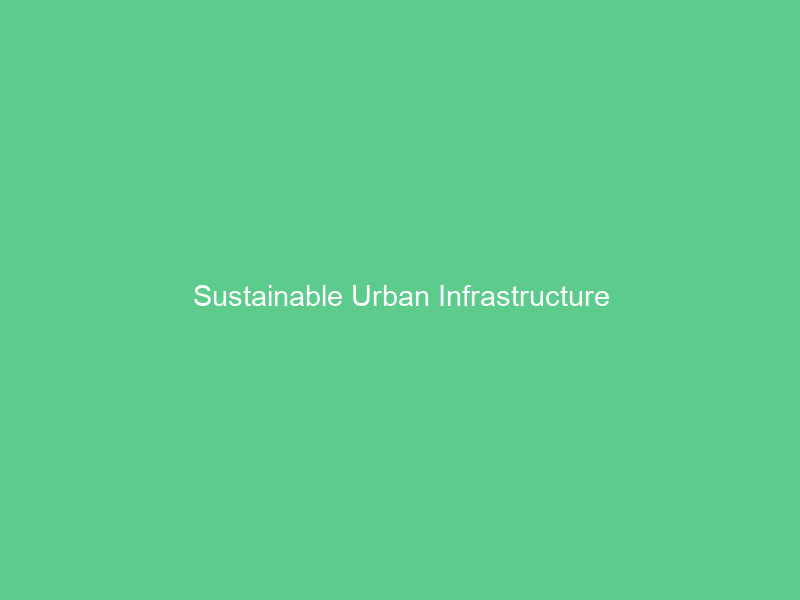Sustainable urban infrastructure seeks to deliver high quality of life while remaining ecologically and socially sustainable. One approach is incorporating nature into cities by creating green spaces and eco architecture.
Copenhagen promotes cycling as an effective mode of transportation, leading to many residents using this mode for daily commuting purposes and helping reduce its carbon footprint.
Infrastructure for a sustainable future
Urban infrastructure is one of the major barriers to sustainable urban growth. It plays an essential role in supporting residents’ daily needs such as water management and waste disposal systems as well as transportation networks; supporting economic activity in local communities while decreasing environmental degradation; by investing in sustainable infrastructure cities can create new economic opportunities, improve public health outcomes and ensure long-term prosperity.
Green infrastructure transforms urban environments, creating sustainable solutions through nature-based solutions such as urban parks, rain gardens and green roofs. This ecosystem helps improve air quality, reduce carbon emissions and regulate temperatures – plus can manage stormwater runoff while strengthening resilience against climate change impacts.
Eco vehicles and effective city planning are also key components of sustainability. A city can reduce traffic congestion and pollution by offering alternative forms of transport such as bike paths or ridesharing systems, while simultaneously supporting green initiatives through EV charging stations or green waste programs.
Public-private partnerships
Increased private-sector participation in infrastructure projects can produce greater efficiency gains, but should be carefully structured. One common method is through public-private partnerships (P3s). P3s are contractual arrangements in which private companies participate in designing, constructing, financing and operating the project over its lifecycle; often including risk transfer features designed to encourage them to accept commercial and financial risks that traditional procurement approaches do not address.
Green infrastructure can be utilized to reduce stormwater runoff, cool streets and neighborhoods, improve air quality, decrease the urban heat island effect, boost biodiversity and support health in communities. Such green infrastructure includes practices such as permeable pavements, rain gardens, soil cells and green roofs.
Nature-based infrastructure (NBI) offers cost-effective climate-resilient infrastructure services at a lower cost, while providing multiple co-benefits to cities. NBI should form part of citywide sustainable infrastructure planning efforts.
Education
Education students on urban sustainability is an integral component of creating sustainable city buildings. However, doing so involves shifting away from traditional lecture-style pedagogy based on passive learning models in favor of more participatory and interactive approaches that put students directly into their learning process – this approach will give students more knowledge of challenges and solutions related to sustainability while increasing comfort levels with these issues.
This study investigates the effectiveness of various methodologies for teaching urban sustainability. It demonstrates that hands-on experiences and project-based work provide the ideal way to teach this topic, emphasizing its relationship to environmental context, built infrastructure and human communities while teaching students empathy as well as critique in responding to any emerging challenges that emerge within cities.
The results of the course evaluation demonstrate that students’ self-assessments of their general knowledge of urban sustainability increased substantially during studio and term project phases, as did their ability to balance economic vitality, environmental quality, cultural heritage preservation and social equity considerations in an equitable manner.
Climate-resilient infrastructure
Cities with high levels of sustainability tend to be more resilient against climate change and other environmental influences, including heat loss through windows; sustainable transportation options like bike lanes, rideshare systems and public transport; green spaces that improve air quality while providing recreational areas; and energy-efficient buildings.
Infrastructure is part of a complex adaptive system and must be designed and constructed with resilience in mind. This practice is known as systems thinking. Resilient designs emphasize qualities such as redundancy, adaptive capacity and flexibility into their system designs.
Governments can play an essential role in developing more resilient infrastructure by prohibiting construction in high-risk areas, mandating resilience standards and amending insurance policies to reflect climate impacts, educating about sustainable practices through education campaigns, as well as engaging residents through awareness programs. All of these measures can help cities become more resistant to climate hazards while improving residents’ quality of life.

